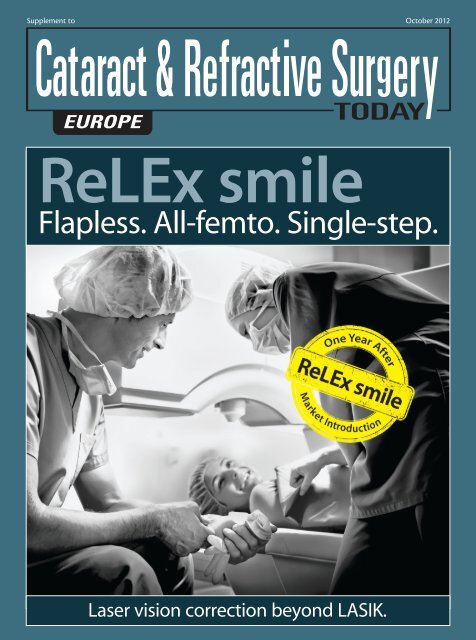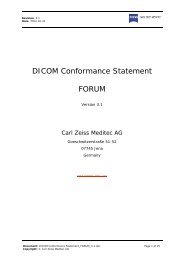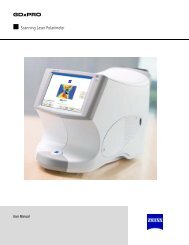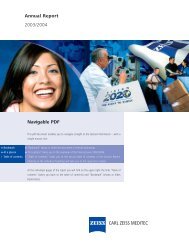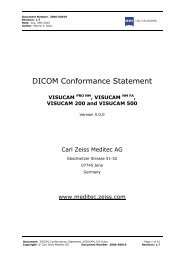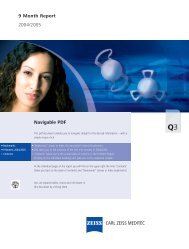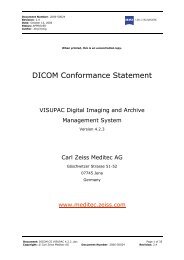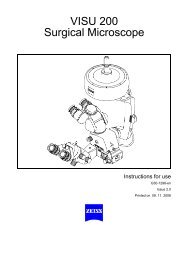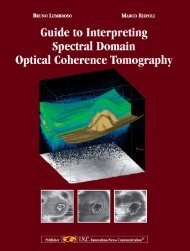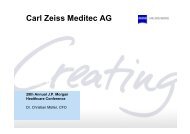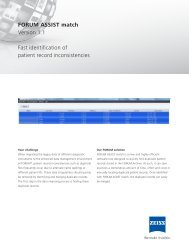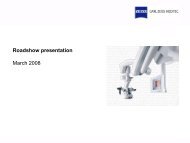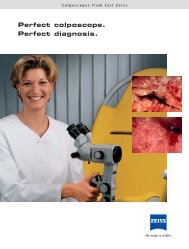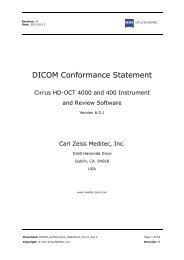Download - Carl Zeiss Meditec AG
Download - Carl Zeiss Meditec AG
Download - Carl Zeiss Meditec AG
You also want an ePaper? Increase the reach of your titles
YUMPU automatically turns print PDFs into web optimized ePapers that Google loves.
Supplement to October 2012<br />
ReLEx smile<br />
Flapless. All-femto. Single-step.<br />
Laser vision correction beyond LASIK.
3 Biomechanical Advantages of ReLEx smile<br />
By Cynthia J. Roberts, PhD; Abhijit Sinha Roy, PhD;<br />
William J. Dupps, MD, PhD; and Jesper Hjortdal, MD, PhD<br />
ReLEx smile: Flapless. All-femto. Single-step.<br />
ReLEx smile<br />
Flapless. All-femto. Single-step.<br />
CONTENTS<br />
5 The Effects of Refractive Surgery on Dry Eye Syndrome<br />
and Corneal Sensation<br />
By Kimiya Shimizu, MD<br />
7 Efficacy and Safety With ReLEx smile<br />
By Jodhbir S. Mehta, MD<br />
9 What We Have Achieved With ReLEx<br />
By Rainer Wiltfang, MD<br />
11 ReLEx smile: A Technique for All Practices<br />
By Cati Albou-Ganem, MD<br />
OCTOBER 2012 SUPPLEMENT TO CATARACT & REFRACTIVE SURGERY TODAY EUROPE 3
ReLEx smile: Flapless. All-femto. Single-step.<br />
Biomechanical Advantages<br />
of ReLEx smile<br />
Compared to LASIK, this flapless refractive surgery technique maintains a stress pattern<br />
that more closely resembles the unoperated cornea.<br />
BY CYNTHIA J. ROBERTS, PhD; ABHIJIT SINHA ROY, PhD; WILLIAM J. DUPPS, MD, PhD;<br />
AND JESPER HJORTDAL, MD, PhD<br />
For more than 1 year now, surgeons have been using<br />
ReLEx smile to provide patients with refractive correction<br />
via lenticule extraction. Although there are<br />
numerous potential benefits compared with LASIK, this<br />
article will focus on the biomechanical advantages of the<br />
ReLEx smile cap as compared with the LASIK flap.<br />
ReLEx is exclusively performed with the VisuMax<br />
femtosecond laser (<strong>Carl</strong> <strong>Zeiss</strong> <strong>Meditec</strong>). This minimally<br />
invasive procedure uses tissue removal with two femtosecond<br />
incisions that intersect to create a lenticule for<br />
extraction, in place of tissue ablation, which is the mechanism<br />
of action for LASIK and PRK corrections. From<br />
results thus far, several surgeons have shown that ReLEx<br />
smile introduces very little spherical aberration across<br />
the optical zone and increases treatment efficiency, especially<br />
for higher refractive errors, because only two incisions<br />
are needed to create a lenticule independent of the<br />
level of correction and only one laser is used.<br />
Dr. Hjortdal has been using ReLEx smile for 18 months.<br />
He has also seen similar trends, and his patients have<br />
been happy with their postoperative outcomes.<br />
However, the scientist side of him wanted to know<br />
Figure 1. Meshing was performed in Truegrid with 8-noded, linear, hexahedral<br />
elements.<br />
4 SUPPLEMENT TO CATARACT & REFRACTIVE SURGERY TODAY EUROPE OCTOBER 2012<br />
The ReLEx smile cap created<br />
less of a defect in the anterior<br />
surface [compared with LASIK],<br />
and thus had a central surface<br />
stress that was closer to the<br />
preoperative state.<br />
more, which led to a collaboration with Drs. Roberts,<br />
Dupps, and Sinha Roy for biomechanical modeling.<br />
Specifically, could this procedure provide higher biomechanical<br />
stability compared with traditional LASIK<br />
as well as femtosecond LASIK?<br />
THE ReLEx smile CAP<br />
With ReLEx smile, there is no longer a need to create a<br />
corneal flap. Instead, a small side cut incision is created at<br />
an approximate depth of 100 to 120 µm in the cornea for<br />
lenticule extraction, creating a smile cap. The obvious benefits<br />
of cap creation are that (1) complications associated<br />
with the LASIK flap cut, including<br />
incomplete and irregular flap cuts,<br />
thin flaps, buttonholes, and free<br />
caps, are eliminated and (2) reduced<br />
risk of induced astigmatism related<br />
to flap complications.<br />
We hypothesize, however, that<br />
there are additional biomechanical<br />
advantages to ReLEx cap creation<br />
over a flap. Therefore, we recently<br />
designed a nonlinear, anisotropic,<br />
fiber-dependent material model<br />
to compare the biomechanical<br />
consequences of ReLEx smile to a<br />
standard LASIK procedure.<br />
To create this model, we used
Figure 2. Results of the simulations. Row 1: three Von Mises stress maps at the<br />
surface of the cornea; row 2: stress maps at the level of the residual stromal bed.<br />
(red = greater stress; blue = lower stress)<br />
topography from a normal patient to construct a 3-D<br />
finite element model, including a 53-µm epithelium of<br />
constant thickness and using the Munnerlyn algorithm<br />
for an equivalent spherical treatment in both ReLEx<br />
smile and LASIK models.<br />
COMPARISON OF TENSION-BEARING LAMELLAE<br />
In the finite element model, the LASIK flap and ReLEx<br />
smile cap were simulated with equivalent dimensions of<br />
width and thickness, thus allowing us to focus the comparison<br />
on the differences in the pattern of disrupting<br />
the continuity of tension-bearing lamellae in each procedure.<br />
The wound interface between either the LASIK<br />
flap or the ReLEx smile cap and the residual stromal bed,<br />
as well as the sidecuts, were simulated as a thin layer of<br />
20-µm thickness. Meshing was performed in Truegrid<br />
with 8-noded, linear, hexahedral elements (Figure 1).<br />
The results of the simulations are shown in Figure 2.<br />
In row 1, three Von Mises stress maps at the surface of<br />
the cornea are depicted. Von Mises stress is the equivalent<br />
stress of the three principal stresses at a point. Row 2<br />
shows these stress maps at the level of the residual stromal<br />
bed. In both rows, the color red correlates with greater<br />
stress, whereas the color blue correlates with lower stress.<br />
Still referring to Figure 2, the first column represents<br />
a cornea of similar postoperative thickness but without<br />
flap/cap creation or tissue removal; the second column<br />
is after a LASIK procedure, and the third is after a ReLEx<br />
smile procedure. Both procedures were simulated with<br />
either a LASIK flap or ReLEx smile cap thickness and<br />
diameter of 100 µm and 9 mm, respectively. Although<br />
Figure 2 illustrates a 9.00 D treatment, the stress pattern<br />
was similar for all simulated corrections.<br />
RESULTS<br />
This study showed that the LASIK flap did not bear the<br />
ReLEx smile: Flapless. All-femto. Single-step.<br />
same stress as it had preoperatively. This<br />
was due to the severing of a substantial<br />
number of tension-bearing lamellae,<br />
resulting in reduced central stress at the<br />
corneal surface compared with the preoperative<br />
state. Because the stress was<br />
transferred to the residual stromal bed,<br />
the central stress increased within the<br />
posterior cornea to a greater magnitude<br />
than the preoperative state.<br />
The ReLEx smile cap, however, created<br />
less of a mechanical insult to the<br />
anterior cornea, and thus had a central<br />
surface stress that was closer to the<br />
unoperated state. Additionally, the<br />
central stress at the level of the residual<br />
stromal bed was also closer to the<br />
unoperated stress pattern. The posterior<br />
corneal stress was much lower<br />
than with LASIK.<br />
CONCLUSION<br />
Our study showed theoretical clear biomechanical<br />
advantages of ReLEx smile over flap-based corneal<br />
refractive surgery. Compared with LASIK, ReLEx smile<br />
treatments maintained a stress pattern that was much<br />
closer to the unoperated cornea in both magnitude and<br />
distribution.<br />
William J. Dupps, MD, PhD, is a refractive and<br />
corneal surgeon at the Cleveland Clinic Cole Eye<br />
Institute. Dr. Dupps states that he has received<br />
research funding from <strong>Carl</strong> <strong>Zeiss</strong> <strong>Meditec</strong>. He<br />
may be reached at tel: +1 216 444 8396.<br />
Jesper Hjortdal, MD, PhD, is a Clinical<br />
Professor of Ophthalmology and a refractive<br />
and corneal surgeon in the Department of<br />
Ophthalmology, Aarhus University Hospital,<br />
Denmark. Dr. Hjortdal states that he has no<br />
financial interest in the products or companies<br />
mentioned. He may be reached at tel: +45 7846 3221;<br />
e-mail: jesper.hjortdal@dadlnet.dk.<br />
Cynthia J. Roberts, PhD, is Professor of<br />
Ophthalmology and Biomedical Engineering<br />
at The Ohio State University in Columbus. Dr.<br />
Roberts states that she has received research<br />
funding from <strong>Carl</strong> <strong>Zeiss</strong> <strong>Meditec</strong>. She may be<br />
reached at tel: +1 614 292 1831; e-mail: roberts.8@osu.edu.<br />
Abhijit Sinha Roy, PhD, is a Research Associate<br />
at the Cleveland Clinic Cole Eye Institute. Dr.<br />
Sinha Roy states that he has received research<br />
funding from <strong>Carl</strong> <strong>Zeiss</strong> <strong>Meditec</strong>. He may<br />
be reached at tel: +1 513 255 0561; e-mail:<br />
asroy27@yahoo.com.<br />
OCTOBER 2012 SUPPLEMENT TO CATARACT & REFRACTIVE SURGERY TODAY EUROPE 5
ReLEx smile: Flapless. All-femto. Single-step.<br />
The Effects of Refractive<br />
Surgery on Dry Eye Syndrome<br />
and Corneal Sensation<br />
As a flapless and minimally invasive procedure, ReLEx smile has the potential to cause fewer<br />
dry eye symptoms compared with femtosecond LASIK.<br />
BY KIMIYA SHIMIZU, MD<br />
It is not uncommon for a<br />
patient to suffer from dry<br />
eye syndrome after refractive<br />
surgery. In many of<br />
these cases, however, the dry<br />
and itchy side effects result<br />
from the LASIK flap and not<br />
from the actual refractive<br />
treatment. In procedures<br />
that do not require a flap,<br />
such as <strong>Carl</strong> <strong>Zeiss</strong> <strong>Meditec</strong>’s<br />
ReLEx smile treatment, these<br />
symptoms are much less<br />
common. For this and many<br />
other reasons, ReLEx smile is<br />
now my procedure of choice<br />
for patients who desire<br />
refractive correction.<br />
SHIFTING OF MY<br />
SURGICAL PREFERENCES<br />
I started performing refractive surgery in Japan in the<br />
1990s. In the early part of the decade, I started performing<br />
PRK and radial keratotomy (RK) and, in 1997, I began<br />
to perform LASIK. I transitioned to LASIK because of the<br />
promise for better visual recovery and less pain, and I<br />
believed that it was a better procedure compared with<br />
surface ablation or RK. For the next 11 years, I performed<br />
LASIK in the majority of my patients and enjoyed excellent<br />
results and successful surgeries.<br />
In 2008, I stopped performing LASIK in favor of other<br />
procedures. The biggest reason for my decision is that I<br />
began to worry about the long-lasting dry eye symptoms<br />
(Figure 1A) that became increasingly more common in<br />
my LASIK patients. Because dry eye syndrome becomes<br />
A<br />
Figure 1. (A) Dry eye, (B) infection, (C) epithelial ingrowth, (D) IOP-induced interlamellar<br />
stromal keratitis, (E) diffuse lamellar keratitis, and (F) corneal perforation can all occur<br />
after LASIK, as a result of flap creation.<br />
6 SUPPLEMENT TO CATARACT & REFRACTIVE SURGERY TODAY EUROPE OCTOBER 2012<br />
B C<br />
D E F<br />
more prominent with age, some of my older patients<br />
began to return to the clinic complaining of dry eyes as<br />
well as other corneal sensations.<br />
Another reason that I decided to abandon LASIK is<br />
that patients who have undergone this treatment can<br />
experience decreased visual performance, including<br />
increased higher-order aberrations and onset of presbyopia.<br />
Infections (Figure 1B), epithelial ingrowth (Figure<br />
1C), intraocular pressure (IOP)-induced interlamellar<br />
stromal keratitis (Figure 1D), diffuse lamellar keratitis<br />
(Figure 1E), and corneal perforations (Figure 1F) can also<br />
occur after LASIK. These are mainly the result of flap creation,<br />
as it involves cutting the trigeminal nerve affects<br />
corneal sensation.
A B<br />
A B<br />
Figure 2. (A) In vivo confocal microscopic images of corneal<br />
subbasal nerve plexuses 1 month after ReLEx smile. (B) In vivo<br />
confocal microscopic images of corneal subbasal nerve<br />
plexuses 1 month after LASIK.<br />
TRIGEMINAL NERVE DENSITY TESTING<br />
We recently examined the changes in trigeminal<br />
nerve density by studying the nerve structure under a<br />
confocal specular microscope before and after LASIK<br />
flap creation in 44 eyes (22 patients). Compared with<br />
preoperative levels, trigeminal nerve density decreased<br />
to 10% and 15% at 1 and 3 months, respectively<br />
(Figure 2). This confirmed our decision to forego LASIK<br />
for other, in my opinion, safer refractive surgery procedures.<br />
In order to prevent this decrease in trigeminal nerve<br />
density, we transitioned to flapless refractive surgery<br />
procedures. The newest refractive correction that does<br />
not require a flap is ReLEx smile. Using the VisuMax<br />
femtosecond laser (<strong>Carl</strong> <strong>Zeiss</strong> <strong>Meditec</strong>), a refractive<br />
lenticule is created in the intact cornea and removed<br />
through a small incision of less than 4 mm, compared<br />
with the 20- to 25-mm incision required for the LASIK<br />
flap sidecut (Figure 3).<br />
After we gained experience with ReLEx smile, we<br />
returned to our initial study design to test the trigeminal<br />
nerve density before and after surgery in 44 eyes. With<br />
ReLEx smile, trigeminal nerve density decreased to 50%<br />
and 60% at 1 and 3 months after ReLEx smile surgery,<br />
respectively. Comparing the numbers from these two<br />
studies, we were able to show that, although both surgical<br />
techniques cause density decrease, ReLEx smile has<br />
the potential to preserve trigeminal nerve density far<br />
better than LASIK.<br />
CONCLUSION<br />
In addition to the preservation of trigeminal nerve<br />
density, ReLEx smile uses less energy and a smaller<br />
spot size than LASIK and therefore creates a smooth<br />
surface. Additionally, the short treatment time, which<br />
is independent from the degree of myopia, translates<br />
ReLEx smile: Flapless. All-femto. Single-step.<br />
Figure 3. (Left) LASIK flap and the (right) ReLEx smile cap.<br />
Figure 4. ReLEx smile: postoperative day 1.<br />
to a short suction time and a short and low rise in<br />
IOP. These things increase the safety of the procedure.<br />
Additionally, not only is ReLEx smile minimally invasive,<br />
but it also induces minimal corneal nerve damage<br />
because the intrastromal lenticule and access cut are<br />
completed in one step and manual tissue separation<br />
and extraction of the refractive lenticule is possible<br />
through a small (4-mm) incision. Figure 4 shows an<br />
operated eye 1 day after ReLEx smile.<br />
Patients typically experience less pain after ReLEx<br />
smile versus LASIK, although pain is not common with<br />
either procedure, and we have not experienced any<br />
complications associated with ReLEx smile. Because<br />
ReLEx smile has good predictability, safety, and efficacy,<br />
we are more confident when offering this procedure to<br />
patients.<br />
For the reasons outlined above, we replaced LASIK<br />
with ReLEx smile in the majority of our patients,<br />
especially for myopic corrections up to -6.00 D.<br />
Kimiya Shimizu, MD, is a Professor of<br />
Ophthalmology and Chair of the Department of<br />
Ophthalmology, Kitasato University, Japan. Dr.<br />
Shimizu states that has no financial interest in<br />
the products or companies mentioned. He may<br />
be reached at e-mail: kimiyas@med.kitasato-u.ac.jp.<br />
OCTOBER 2012 SUPPLEMENT TO CATARACT & REFRACTIVE SURGERY TODAY EUROPE 7
ReLEx smile: Flapless. All-femto. Single-step.<br />
Efficacy and Safety With<br />
ReLEx smile<br />
An overview of the clinical advantages of this procedure.<br />
BY JODHBIR S. MEHTA, MD<br />
ReLEx smile may just be the paradigm shift in laser vision<br />
correction that refractive surgeons have been waiting<br />
for. Instead of weakening the biomechanical stability<br />
with ablation procedures such as LASIK, surgeons<br />
now have the ability to perform refractive correction by<br />
creating a lenticule inside the intact cornea and subsequently<br />
removing it through a small (less than 4 mm)<br />
incision. This technique does not completely sever nerve<br />
pathways and avoids the need to create a flap, which<br />
provides surgeons with the opportunity to perform<br />
minimally invasive refractive corneal surgery.<br />
This article overviews the clinical advantages of lenticule<br />
extraction compared with the most commonly<br />
performed refractive surgery technique in the world:<br />
LASIK. If the excellent results with ReLEx smile continue,<br />
we believe that it has the potential to overtake LASIK in<br />
terms of popularity. Because ReLEx smile is flapless and<br />
requires an 80% smaller sidecut incision in the anterior<br />
cornea and a 30% smaller lamellar incision (cap cut)<br />
than the LASIK flap, biomechanical stability is minimally<br />
reduced and dry eye syndrome avoided.<br />
EARLY STUDIES<br />
In our first preclinical study, 1 my colleagues and I performed<br />
a paired eye study in 36 rabbits to compare ReLEx<br />
flex with standard LASIK. Although ReLEx flex requires flap<br />
creation, it is typically just 0.5 to 1.0 mm larger in diameter<br />
than the optical zone. In the first study, 18 rabbit eyes<br />
underwent ReLEx flex and 18 underwent LASIK. In each<br />
group, we looked at three refractive correction subgroups,<br />
-3.00, -6.00, and -9.00 D, to determine the differences of<br />
the two procedures in early wound-healing responses.<br />
This study showed that, compared with LASIK, ReLEx had<br />
a better postoperative wound-healing response, resulting<br />
in less topographic changes, less inflammation, and less<br />
extracelluar matrix deposition. These findings were statistically<br />
significant at high refractive corrections (-6.00 D and<br />
above). There was, however, no difference between the<br />
groups in cell death and proliferation after surgery.<br />
Our take-home message from this study was that,<br />
with ReLEx, approximately the same amount of energy<br />
8 SUPPLEMENT TO CATARACT & REFRACTIVE SURGERY TODAY EUROPE OCTOBER 2012<br />
is applied to the eye regardless of the level of correction.<br />
The energy is equivalent to approximately 0.58 J. With<br />
LASIK, however, the energy required to complete the<br />
ablation increases as the level of correction increases.<br />
Therefore, the energy can range from 4 J for a low correction<br />
to 12 J, for instance, for a -9.00 D correction.<br />
After we determined that ReLEx resulted in good postoperative<br />
wound healing in rabbit eyes, we began to wonder<br />
if the laser cuts required for the procedure would affect the<br />
stromal bed quality with different ablations. Did these cuts<br />
in the cornea make the stromal bed rougher than preoperatively,<br />
and would that result in slower visual recovery?<br />
Would the stromal bed be roughest in higher myopic eyes<br />
because deeper cuts were required? To answer these questions,<br />
we performed a prospective clinical case series in 33<br />
patients who underwent ReLEx flex in both eyes 2 and a<br />
human eye-bank study on donor cadaver eyes to look at<br />
stromal bed smoothness on scanning electron microscopy.<br />
During this human eye-bank study, we were able to<br />
show that the degree of roughness of the stromal bed<br />
was independent of the level of myopic correction. The<br />
laboratory results were supported by the clinical visual acuity<br />
results. The mean preoperative spherical equivalent (SE)<br />
was -5.77 ±2.04 D, improving to 0.14 ±0.53 D at 3 months<br />
postoperatively. Additionally, UCVA in 94% of eyes was<br />
20/25 or better at 3 months, and all eyes achieved refractive<br />
stability within 1 month after surgery (P
surgeons assume that introducing a new technology may<br />
compromise the safety and efficacy of a well-established<br />
procedure. However, we experienced the opposite. In fact,<br />
our previous results with the microkeratome—even in our<br />
best year—are inferior to our results with the femtosecond<br />
laser—even in the early years of its inception in 2008.<br />
We expected there may be a dip in postoperative results<br />
when we started performing ReLEx. Because we have such<br />
an extensive database of surgical results, it has been very<br />
easy for us to compare results with ReLEx and LASIK. Not<br />
only have our ReLEx flex results matched our femtosecond<br />
LASIK results, but this has been achieved without any specific<br />
nomogram adjustment to optimize our outcomes.<br />
We have also performed a study in 1,500 eyes that<br />
underwent myopic LASIK and 100 eyes that underwent<br />
ReLEx for myopia correction. We matched the eyes for<br />
their preoperative level of myopic correction and found<br />
that the visual outcomes in both groups were similar. The<br />
other thing that we were able to show in this study is that<br />
not only was the safety and efficacy equivalent in these<br />
two groups but when we looked at the eyes that had<br />
between -5.00 and -10.00 D of myopia preoperatively, the<br />
ReLEx eyes had better predictability than the LASIK eyes.<br />
TRANSITIONING TO ReLEx smile<br />
Today, we have transitioned from ReLEx flex to ReLEx<br />
smile. This flapless version of the ReLEx technique is<br />
even less invasive than ReLEx flex. Although we have a<br />
much smaller cohort of results to draw from, we have<br />
compared our newest ReLEx smile results to our results<br />
with not only femtosecond LASIK but also with ReLEx<br />
flex. What we are seeing is that ReLEx smile increases<br />
upon the safety and efficacy that we were able to<br />
achieve with ReLEx flex. Additionally, a much higher<br />
number of patients achieve 20/16 vision than compared<br />
with our femtosecond LASIK patients.<br />
We believe that the reason for the improvement in<br />
results between ReLEx flex and ReLEx smile has to do with<br />
the elimination of flap creation. We have observed that for<br />
higher corrections (between -5.00 and -10.00 D) the flap<br />
induces a significant amount of aberrations into the optical<br />
system. I like to use the following analogy to explain<br />
this phenomenon: The anterior cornea is like a suspension<br />
bridge. Therefore, as you cut vertically across the suspension<br />
bridge (ie, flap), you initiate a collapse in the structure.<br />
With ReLEx smile, however, there is only a small vertical<br />
cut and therefore minimal collapse or stromal damage.<br />
In our studies, there were less induced aberrations<br />
after ReLEx flex than after femtosecond LASIK. This year,<br />
we are conducting a follow-up study with ReLEx smile<br />
that will assess induced aberrations.<br />
TAKE A CHANCE ON A NEW TREATMENT<br />
LASIK is perhaps the most well-known, well-documented<br />
elective procedure in the world. It has helped<br />
ReLEx smile: Flapless. All-femto. Single-step.<br />
millions of people worldwide achieve excellent visual<br />
quality without the need for spectacles. However, as<br />
with any procedure, there are disadvantages. In 2009,<br />
Solomon et al 3 published a study showing that approximately<br />
4% to 5% of patients were unhappy after LASIK.<br />
This is a very small percentage; however, if given the<br />
sheer volume of patients who have undergone LASIK,<br />
this equates to a significant number of unhappy<br />
patients. The most common complaints are dry eye<br />
syndrome, problems with night vision or glare, regression,<br />
and complications during flap formation or traumatic<br />
dislocation postoperatively.<br />
Therefore, when we heard about the flapless, minimally<br />
invasive ReLEx smile procedure about 3 or 4 years<br />
ago, we considered switching to this treatment. Because<br />
the cornea is not cut all the way around, as it is for LASIK<br />
flap creation, biomechanical stability should improve,<br />
which should translate into a reduction of the side<br />
effects of LASIK, including post-LASIK ectasia.<br />
Taking a chance on a new treatment is worthwhile if<br />
it can provide our patients with a safer surgery that is<br />
just as effective, if not more effective, than other wellestablished<br />
treatments. I am pleased with the results we<br />
have had with ReLEx smile thus far, and I envision results<br />
continuing to improve as the treatment matures.<br />
At this time, however, an enhancement after ReLEx<br />
smile is challenging. <strong>Carl</strong> <strong>Zeiss</strong> <strong>Meditec</strong> is working on<br />
solving this issue. If regression occurs, one option is to<br />
perform surface ablation. But because ReLEx smile uses a<br />
lot less energy and there is maintenance of corneal integrity,<br />
regression is not as common as it is after LASIK.<br />
CONCLUSION<br />
ReLEx smile provides surgeons the advantages of LASIK<br />
while avoiding the potential side effects related to flap<br />
creation. Biomechanical stability is relatively stronger<br />
after ReLEx smile compared with LASIK, making wound<br />
healing faster after ReLEx smile. Additionally, there is no<br />
surface dryness on the tear break-up time after ReLEx.<br />
This procedure certainly has the potential to overtake<br />
LASIK as the procedure of choice for most patients.<br />
Jodhbir S. Mehta, MD, is Associate Professor<br />
and Co-Head of the Corneal and External<br />
Disease Service, is a Consultant at the Refractive<br />
Service Singapore National Eye Centre, and is<br />
Associate Professor at DUKE-NUS and YLL,<br />
School of Medicine NUS. Dr. Mehta did not provide financial<br />
disclosure information. He may be reached at e-mail: jodmehta@gmail.com.<br />
1. Riau AK, Angunawela RI, Chaurasia SS, et al. Early corneal wound healing and inflammatory<br />
responses after refractive lenticule extraction (ReLEx). IOVS. 2011;52(9):6213-6221.<br />
2. Ang M, Chaurasia SS, Angunawela RI, et al. Femtosecond lenticule extraction (FLEx):<br />
Clinical results, interface evaluation, and intraocular pressure variation. IOVS. 2012;53(4).<br />
3. Solomon KD, de Castro F, Sandoval H, et al. LASIK world literature review; Quality of life<br />
and patient satisfaction. Ophthalmology. 2009;116(4):691-701.<br />
OCTOBER 2012 SUPPLEMENT TO CATARACT & REFRACTIVE SURGERY TODAY EUROPE 9
ReLEx smile: Flapless. All-femto. Single-step.<br />
What We Have<br />
Achieved With ReLEx<br />
Continuous improvement of settings helped to improve cut quality and tissue separation<br />
and reduce treatment time and improve visual outcomes on postoperative day 1.<br />
BY RAINER WILTFANG, MD<br />
Every femtosecond laser system has optimal settings<br />
that, when used properly, allow a smooth treatment<br />
(workflow) and achieve the best possible outcomes<br />
postoperatively. My colleagues and I were wondering if<br />
there was room for improvement for the settings currently<br />
used for performing ReLEx.<br />
During femtosecond laser treatments, the laser’s<br />
pulses create gas bubbles that bind together in the<br />
intrastromal surface. In some instances, because of the<br />
high level of energy being applied to the eye, a transient<br />
opaque bubble layer can form temporarily, especially<br />
when using thin flaps. Another concern with femtosecond<br />
laser use is Christmas tree formation. In Christmas<br />
tree formation, the gas bubbles move into neighboring<br />
tissue layers and form white patterns that resemble a<br />
Christmas tree. Both issues result in compromised cut<br />
quality and can lead to difficult tissue separation.<br />
My colleagues and I began studying the possible<br />
parameters of influence, which included spot spacing,<br />
track spacing, and energy level, as well as the relationship<br />
between those parameters (ie, energy/area). We<br />
presumed that both the amount of energy placed in<br />
the eye as well as the area with which the energy was<br />
applied influences the occurrence of the opaque bubble<br />
layer and Christmas tree formation. Furthermore,<br />
we hypothesized that use of lower energy in a tighter<br />
area would reduce the incidence of both side effects.<br />
We decided to test the following two parameters:<br />
(1) keep the spot and track spacing at their original<br />
settings while reducing the energy and (2) enlarge the<br />
track and spot spacing while keeping the energy per<br />
area at approximately the same levels. These tests were<br />
to be performed initially in pig eyes.<br />
STUDY APPROACH<br />
The first parameter we tested was energy density, where<br />
we reduced the energy while using the same spot spacing.<br />
This test helped us determine the smallest energy density<br />
possible that still achieved adequate tissue separation.<br />
10 SUPPLEMENT TO CATARACT & REFRACTIVE SURGERY TODAY EUROPE OCTOBER 2012<br />
Our next step was to find a way to reduce the<br />
amount of energy density being applied to the eye<br />
without reducing the effectiveness of the treatment by<br />
increasing the spot spacing. We again tested parameters<br />
in pig eyes and were able to reduce energy levels<br />
per surface area of the treatment. From these studies,<br />
we were much closer to determining the best combination<br />
of spot spacing and energy level that would<br />
achieve maximal cut quality and tissue separation.<br />
FINDINGS<br />
When we started to use these settings in human<br />
eyes, we saw significantly better distance UCVA on<br />
postoperative day 1 and various time points. We also<br />
experienced reduced treatment times, resulting in a<br />
reduced risk of suction loss. The same parameters were<br />
applicable for all treatments, regardless if the patient<br />
required a correction of -3.00 or -8.00 D.<br />
We now know that energy/area greatly affect the<br />
predictability of Christmas tree and opaque bubble<br />
layer formation. With the optimized parameters for<br />
ReLEx, I have not seen any Christmas tree formation<br />
and always experience very easy tissue separation.<br />
Additionally, the opaque bubble layer is not visible<br />
after 2 minutes of treatment, resulting in a clear cornea.<br />
These results are superior when comparing the <strong>Zeiss</strong><br />
system to the IntraLase (Abbott Medical Optics Inc.),<br />
because the IntraLase has a higher energy level.<br />
As mentioned, the enlarged spot and track spacing<br />
also reduced the already short treatment time by up to<br />
30%, or from 30 to 20 seconds. This further reduction<br />
in treatment time leads to a reduced risk of suction<br />
loss, which surgeons find highly beneficial.<br />
DISCUSSION<br />
After optimizing our settings, I am now comfortable<br />
using ReLEx smile to treat patients with -3.00 to -10.00 D<br />
of myopia. I am also able to treat up to 4.00 D of astigmatism<br />
with this technique. In the first 10 eyes I have
Figure 1. A total of 10% of eyes gained 1 line of distance BCVA.<br />
Figure 2. All patients were 0.8 or better on postoperative day 1.<br />
treated with ReLEx smile (-3.00 to -7.00 D of sphere; -0.25<br />
to 2.00 D of cylinder), CDVA remained unchanged in<br />
90%, and 10% gained 1 line (Figure 1). On day 1 postoperative,<br />
all eyes were 0.8 or better, while 90% were<br />
1.0 or better (Figure 2).<br />
What I like about ReLEx smile is its high predictability<br />
rate, as less than 2% of my patients have needed any sort<br />
ReLEx smile: Flapless. All-femto. Single-step.<br />
of enhancement. When<br />
enhancement is needed, I<br />
follow a similar protocol to<br />
enhancements after femtosecond<br />
LASIK. The only difference<br />
is that I create a 60º<br />
sidecut instead of lifting the<br />
270º LASIK flap. I do caution<br />
my patients that enhancement<br />
after ReLEx smile<br />
might result in increased<br />
pain for 2 days.<br />
CONCLUSION<br />
I believe that ReLEx smile<br />
is dramatically changing the<br />
way we practice refractive<br />
surgery. Figuring out the<br />
ideal spot spacing has helped<br />
us maximize the benefits of<br />
ReLEx smile as a treatment<br />
for refractive errors. It seems<br />
to be a stable, predictable,<br />
and safe procedure with<br />
excellent visual outcomes<br />
even on postoperative day<br />
1. Because of a 30% shorter<br />
treatment time, there is less<br />
risk for suction loss. I also<br />
notice that tissue separation<br />
is easier, with more uniformity<br />
in the appearance of<br />
Christmas tree formation<br />
and the opaque bubble layer.<br />
Therefore, it is my feeling<br />
that ReLEx smile is the<br />
future of refractive surgery.<br />
In the next 5 years, we may<br />
begin to see more ReLEx<br />
smile procedures being performed<br />
than femtosecond<br />
LASIK procedures.<br />
Rainer Wiltfang, MD, is Head of the<br />
Department at Smileyes, Munchen, Germany.<br />
Dr. Wiltfang states that he has no financial<br />
interest in the products or companies mentioned.<br />
He may be reached at e-mail: wiltfang@<br />
smileeyes.de.<br />
OCTOBER 2012 SUPPLEMENT TO CATARACT & REFRACTIVE SURGERY TODAY EUROPE 11
ReLEx smile: Flapless. All-femto. Single-step.<br />
ReLEx smile: A Technique<br />
for All Practices<br />
There are plentiful advantages for a modern, high-volume, multi-user clinic like the Clinique<br />
de la Vision in Paris.<br />
BY CATI ALBOU-GANEM, MD<br />
Even in today’s tough economic times, a good number<br />
of patients continue to present for refractive surgery.<br />
We strive to offer patients a cost-effective, efficient<br />
method for refractive correction that will render them<br />
spectacle independent after surgery. When the ReLEx<br />
smile procedure was introduced at the Clinique de la<br />
Vision in Paris, it was like a dream that turned into reality.<br />
Our surgeons wanted to perform the procedure immediately,<br />
as we all thought that flapless, small-incision, minimally<br />
invasive refractive surgery would offer many benefits<br />
to our patients as well as to our practice. Although we<br />
were all excited about the opportunity to perform ReLEx<br />
smile (Figure 1), we decided to roll out the procedure<br />
slowly, first training a handful of surgeons who could then<br />
help to train the rest of our staff.<br />
The Clinique de la Vision employs approximately 50<br />
surgeons, the majority of whom only practice at the clinic<br />
a few times per month. All surgeons use their own individualized<br />
technique, on the laser platform that is most<br />
comfortable for them. We have one WaveLight Allegretto<br />
(Alcon Laboratories, Inc.), two Technolas Excimer<br />
Workstations (Technolas Perfect Vision GmbH), one MEL<br />
80 (<strong>Carl</strong> <strong>Zeiss</strong> <strong>Meditec</strong>), two IntraLase femtosecond lasers<br />
(Abbott <strong>Meditec</strong>al Optics Inc.), one 230 F Femtosecond<br />
Laser (Technolas Perfect Vision GmbH) to perfom<br />
Intracor, and one VisuMax femtosecond laser (<strong>Carl</strong> <strong>Zeiss</strong><br />
<strong>Meditec</strong>). We purchased the VisuMax in October 2011,<br />
and that following month I became one of the first surgeon<br />
to perform ReLEx smile. Now, five surgeons are<br />
performing the procedure at our clinic. We hope to begin<br />
teaching other surgeons the techniques necessary to perform<br />
ReLEx smile over the next few months.<br />
Prior to learning ReLEx smile, I typically performed<br />
LASIK with the IntraLase femtosecond laser and the<br />
Technolas or WaveLight excimer laser. These systems are<br />
very precise, and because of the accuracy of the laser I was<br />
hesitant to switch to using the VisuMax to perform ReLEx<br />
smile. Would my results with ReLEx smile be as impressive<br />
as my results with LASIK? Would the learning curve be<br />
long? Would my patients experience comparable visual<br />
12 SUPPLEMENT TO CATARACT & REFRACTIVE SURGERY TODAY EUROPE OCTOBER 2012<br />
Figure 1. Femtoseconde refractive lenticule. The small circle<br />
is the posterior plan; the large circle is the anterior plan.<br />
quality with this new technique?<br />
Any concerns I had about the procedure quickly disappeared,<br />
because even after the first case I was impressed<br />
with the ease of the technique and the excellent postoperative<br />
results.<br />
LEARNING CURVE<br />
There is a slight learning curve associated with ReLEx<br />
smile, especially with programming the laser, but ReLEx<br />
flex, the version of lenticule extraction requiring a flap,<br />
is a good introduction to the basic surgical technique.<br />
I recommend starting with ReLEx flex for the first few<br />
procedures and transitioning slowly to ReLEx smile after<br />
perfecting the steps of ReLEx flex.<br />
Some high-volume centers shy away from incorporating<br />
new surgical techniques into practice until there is a published<br />
body of long-term results in the literature. However,<br />
the Clinique de la Vision decided to adopt an innovative<br />
technique like ReLEx smile relatively early because, after<br />
a small number of surgeons gained valuable experience,<br />
we deemed it easier to perform on patients with myopia<br />
than LASIK. This accounts for a significant amount of our<br />
patients. LASIK has a good reputation and remains an
Figure 2. The incision is opened.<br />
excellent option for refractive surgery, but because the<br />
ReLEx smile procedure has faster results we believe it is the<br />
better choice for our patients.<br />
When training new ophthalmic specialists, two technicians<br />
or surgeons first observe the procedure and then<br />
assist with subsequent procedures before attempting the<br />
technique themselves. At the Clinique de la Vision, we are<br />
lucky to have skilled technicians and surgeons who learn<br />
very quickly, so they progress to assisting the surgeon<br />
within the first few surgeries.<br />
RESULTS AND ENHANCEMENTS<br />
As I previously mentioned, I was skeptical about the<br />
transition from LASIK to ReLEx smile, but my initial experience<br />
convinced me that it is the superior treatment. At<br />
this time, I prefer to perform ReLEx smile in patients with<br />
-4.00 D or more of myopia. However, I will default to<br />
LASIK if there is a high amount of astigmatism (-2.00 D or<br />
more).<br />
I especially appreciate the small incision size (3 to 4<br />
mm) required with ReLEx smile, and I quickly noticed that<br />
refractive results have been more precise than with other<br />
techniques. I have already performed more than 35 ReLEx<br />
smile procedures and have found that patients are able to<br />
go back to work sooner, and they can watch television or<br />
use their computers only a few hours after surgery. Visual<br />
side effects may linger for a couple of weeks after surgery,<br />
but the procedure is very efficient and patients have been<br />
happy with their results. Additionally, pain is minimal during<br />
and especially after surgery.<br />
Figure 3. Dissection of the anterior plane<br />
of the lenticule.<br />
Figure 5. Lenticule extraction. Figure 6. Final outcome of surgery.<br />
ReLEx smile: Flapless. All-femto. Single-step.<br />
Figure 4. Posterior plane.<br />
One thing to note is that enhancements<br />
after ReLEx can be challenging,<br />
but I have found that the best<br />
strategy is to create a flap and subsequently<br />
perform LASIK. If necessary,<br />
a sidecut incision can be made<br />
to locate the plane of the lenticule.<br />
Once that is found, the surgeon<br />
would cross the cut of the lenticule<br />
and perform the enhancement by<br />
lifting the flap. However, thus far<br />
I have only had one patient who<br />
required an enhancement.<br />
CONCLUSION<br />
I am honored to be one of the first surgeon at Clinique<br />
de la Vision to perform ReLEx smile, and I am extremely<br />
happy with the results so far. I continue to discuss the<br />
benefits of ReLEx smile with my fellow surgeons, and I<br />
have successfully convinced several to try this technique<br />
of refractive correction. Slowly but surely more surgeons<br />
at my clinic are interested in learning ReLEx smile, and I<br />
believe its popularity will continue to grow worldwide.<br />
Currently, patients with high myopia benefit the most<br />
from the ReLEx smile procedure. I also believe that ReLEx<br />
(flex and smile) will eventually replace conventional<br />
femtosecond LASIK, because it is easier to perform, it is<br />
a gentle treatment with a small incision, and patients are<br />
happy after surgery.<br />
Right now, we have a plethora of surgical options to<br />
treat refractive errors, but I feel that ReLEx smile is the<br />
most appropriate choice when treating high myopia.<br />
This has become my go-to surgery in this population,<br />
and I look forward to increasing my indications for ReLEx<br />
smile, as the future potential of ReLEx is promising. I<br />
could imagine that, in the future, we will also be able to<br />
treat hyperopic and possibly even presbyopic patients.<br />
Cati Albou-Ganem, MD, is a founding member<br />
and surgeon at Clinique de la Vision, Paris. Dr.<br />
Albou-Ganem states that she is a paid consultant<br />
to <strong>Carl</strong> <strong>Zeiss</strong> <strong>Meditec</strong> and PhysIOL. She may be<br />
reached at e-mail: cati.ganem@wanadoo.fr.<br />
OCTOBER 2012 SUPPLEMENT TO CATARACT & REFRACTIVE SURGERY TODAY EUROPE 13
NOTES
The moment flapless surgery<br />
becomes clearly visible: in a smile.<br />
This is the moment we work for.<br />
// ReLEx<br />
MadE By CaRL ZEiss<br />
Flapless. All-femto. Single-step. For the first time ever, advanced femtosecond technology and<br />
highly precise lenticule extraction are combined to perform minimally invasive corrections –<br />
with a single system: the VisuMax ® from <strong>Carl</strong> <strong>Zeiss</strong>. Thereby, a refractive lenticule is created<br />
within the intact cornea and extracted through a small incision. The new flapless procedure<br />
offers clear advantages: minimal surgical impact on the corneal stability and excellent predictability<br />
of the refractive outcomes.<br />
www.meditec.zeiss.com/ReLEx<br />
000000-2021-996


